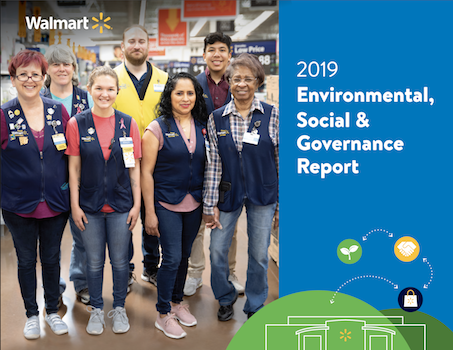Walmart on Track to Reduce 1 Billion Metric Tons of Emissions From Global Supply Chains by 2030
Inaugural Environmental, Social and Governance Report (ESG) outlines how Walmart drives change in the industry and creates shared value
June 7, 2019 - In May, Walmart Inc. (NYSE: WMT) issued its inaugural Environmental, Social and Governance (ESG) Report, which details the company’s goals, progress and achievements for fiscal year 2019 toward its commitment to activate climate change initiatives, enhance sustainability in supply chains and increase economic opportunity for associates.
Walmart is disclosing progress to date in several areas including:
Activating Climate Change Initiatives
- Climate Change Impact Scenario Analysis – Walmart worked with an independent third-party consultant to better understand the nature of climate change and potential implications for the retail sector aiming to align with the scenario guidance set forth by the Task Force on Climate-related Financial Disclosures.
- Reducing Greenhouse Gas Emissions – Walmart reports a 6.1% reduction in Scopes 1 and 2 annual greenhouse gas emissions in 2017 compared with 2015.[i]
- Project Gigaton - Walmart made advancements on its Project Gigaton goals with suppliers reporting avoiding more than 93 million metric tons of emissions over the last two years. Launched in 2017, Project Gigaton is a global effort that invites suppliers to join Walmart in a commitment to avoid 1 billion metric tons of emissions in the company’s collective value chains by 2030.
- Using Renewable Energy - As part of Walmart’s goal of being supplied by 50% renewable energy by 2025, 28% of Walmart’s electricity needs are supplied by renewable sources.[ii]
- Mitigating Waste - In 2018 in the U.S., Walmart diverted 81% of unsold products, packaging and other waste materials from landfills. Walmart also recycled more than 430 million pounds of plastic film and rigid plastics globally.
Enhancing Sustainability in Supply Chains
- Human Rights - The ESG Report includes a discussion of salient human rights issues and progress on related initiatives within the company and through collective action, building on the human rights statement the company published last year bringing together in one place the company’s perspective on respecting human rights in its operations and supply chains.
- Sourcing Responsibly - To help address worker safety issues in the Bangladesh ready-made garment industry, Walmart became a founding member of the Alliance for Bangladesh Worker Safety in 2013. The Alliance concluded its five-year commitment on December 31, 2018, and we have seen significant progress, including 90% of high-priority remediation items completed across all factories affiliated with the Alliance.
- Sustainability Index - As of the end of FY2019, Walmart achieved a supplier Sustainability Index participation rate that covers 80% of the goods Walmart sells in U.S. stores and Sam’s Club locations for categories where the Sustainability Index is available.
Increasing Economic Opportunity for Associates
- Advancing Economic Mobility - Walmart promoted more than 215,000 people to jobs of greater responsibility and higher pay in Walmart U.S. stores in FY2019.
- Fostering Inclusion[iii] - 31% of Walmart’s corporate officers are women, 44% of associates with revenue responsibility are women and 57% of hourly promotions were women. Of the 800,000 Walmart U.S. store associates that have been through the Walmart Academy, 60% of those trained were women. Additionally, 34% of associates with revenue responsibility are people of color.[iv]
- Wages and Benefits - Walmart is committed to the economic mobility of its associates and has shared that the average total compensation and benefits for a full-time, hourly field associate in Walmart U.S. stores is $19.31 as of March 2019.[v]
Walmart’s ESG report is a newly-focused and streamlined update on how the company approaches key issues facing society and initiatives across its business segments that make a difference in both the communities it operates and the world.
Walmart’s ESG report is available at Walmart.com/ESGreport
Media Relations: 1.800.331.0085
news.walmart.com/reporter
[i] Decline in emissions (Scope 1 and 2) between 2015 and 2017, is adjusted for most recent grid factors. On an unadjusted basis (as reported to CDP, using grid factors available in the year of reporting), the decline was 11.2%. Measurement accounts for changes in majority-owned subsidiaries over time through corresponding adjustments to baseline and year of measurement.
[ii] This considers the combined contribution of the renewable energy credits and power generated from onsite and offsite projects as well as renewable energy that we receive from utility-owned renewable generation feeding into the grids where our sites are located. At the time this report was prepared, calendar year 2017 was the most recent year for which we have third-party-verified energy consumption data. This was used in combination with the electricity procured from our renewable energy projects in 2018 and the most recent grid fuel mix information obtained from the International Energy Agency for the regions where we operate.
[iii] Diversity & inclusion numbers are calculated based upon total U.S. workforce, including associates in the U.S. regardless of whether assigned to subsidiary that owns or operates an ecommerce business, platform and/or marketplace.
[iv] Individuals with revenue producing responsibility are those U.S. corporate and field managers with P&L responsibilities.
[v] Based upon average hourly wage calculated for full time associates assigned to Walmart U.S. stores, excluding Health and Wellness, as of March 15, 2019, plus value of FY2019 benefits.



